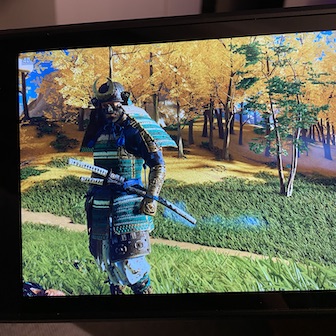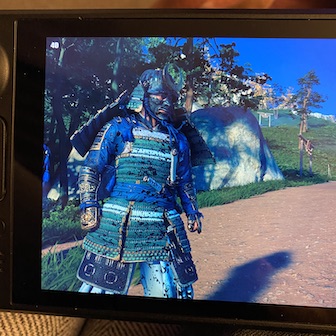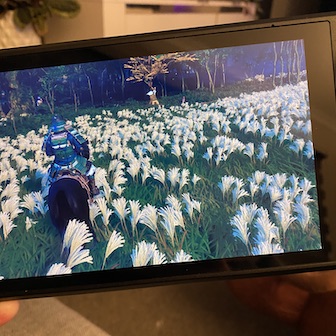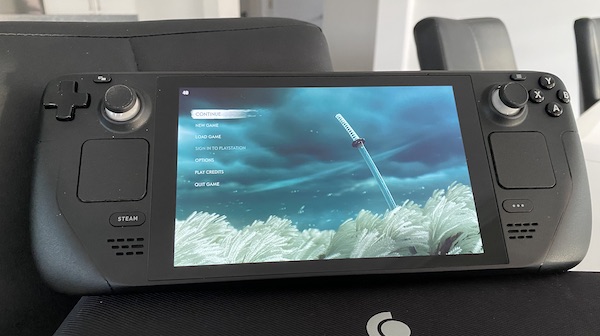Ghost of Tsushima PC (reviewed on Steam Deck)
Ghost of Tsushima was my favourite game of 2020 so you can imagine my delight when the esteemed editor-in-chief of this site asked if I’d be willing to review the PC version, that has been ported by fabled dutch master Nixxes.
“Don’t have to ask me twice,” I chirped, given I’d already completed the game on PlayStation 4 and then played it on PlayStation 5: I jumped at the chance to play it on PC.
Like a four-year-old at Christmas, I excitedly typed in the Steam code and downloaded the game onto both my ageing PC (which still has a relatively capable AMD RX580 graphics card) and my Valve Steam Deck, as it was really the handheld that I wanted to experience the game on.
So, would I have a pleasant experience playing one of my favourite PlayStation games, from one of my favourite developers (Sucker Punch), on the go on a handheld? Bloody right, I would be – and what a joy to behold it is.
Ghost of Tsushima, for those that don’t know about it, is tells the tale of 13th century Japanese samurai Jin Sakai who must fight against an invading Mongol horde that threatens to wipe out not only his homeland but his entire bloodline after his uncle is captured by evil Mongol leader. It’s originally came out on the PS4 and it is a game jam packed with beautiful vistas, serene sunsets, rolling meadows, vibrant flowers … and heads being lopped off with a katana sword. Oh, my.
Ghost of Tsushima, a Steam Dream.
Upgrades for the PC version (over the PS version) include unlocked framerates, Ultrawide (21:9), Super Ultrawide (32:9) and even 48:9 Triple Monitor support, and upscaling and frame generation technologies like NVIDIA DLSS 3, AMD FSR 3 and Intel XeSS, as well as mouse and keyboard support (obviously).
Setting up Ghost on the Steam Deck was a breeze (although as with many games, the text is a little small so I needed to squint a bit to read it). The game doesn’t have Deck verified status yet but that’s due to the multiplayer mode requiring WIndows to access a PSN account (Sony have rightly received grief lately online by requiring a PSN network account for his PC releases moving forward. Not a good look Sony.)


Setting the SD graphics to high texture quality, low shadows, high level of detail, medium terrain detail, volumetric fog low, depth of field very low, screen space reflections and shadows low, ambient occlusion to performance (there is also a balanced or graphics option) and 4 x anisotrophic filtering (as well as limiting the Steam Deck’s own screen frame rate to 40 FPS), I was chuffed that I was pretty much maintaining close to maintaining 40 frames per second throughout the game, even during combat, which is some of the best third-person sword play I’ve experienced in a game.
On my original Steam Deck’s LCD screen (I don’t have the new fangled OLED model) Ghost of Tsushima looks, frankly, stunning, with the visuals often requiring moments when you just stop Jin in his tracks – whether it while walking slinking through a meadow full of vibrant violet flowers or a forest with golden-leafed trees – and just soak in what is around you.
It truly is a visual spectacle. A jaw dropping experience.
There’s the odd shimmer in background visuals from time time, generally things like flames and sparks, and it can drain the battery as you’d expect, but with the settings I mentioned above, I reckon I’m getting about 2 hours-plus out of a full battery, which suits me fine.
I’ve experienced no other issues while playing on my Steam deck: No audio bugs, no standoff bugs as some people are experiencing, although I noticed that I had black shimmering water at times when playing on my PC (with the RX580 GPU). It’s been a problem-free experience on SD.


Ghost of Tsushima has been my go to game for the past week or so. It’s just perfect for the Steam Deck. It just looks wonderful on the smaller real estate and stunning visuals aside, the combat is fluid, too, relying on blocks and parries to knock larger, tougher enemies off balance.
Encounters tend to be blood-soaked affairs and it really is worth deviating from the main story for a bit as you’ll discover all sorts of tales and secrets that just add to the lore and backstory of what happened during the Mongol invasion.
What’s not to love about being able to slice a Mongol warrior in half during a cinematic standoff while your other half is watching her favourite evening soap opera on the TV your consoles are connected to?





